| Columns Retired Columns & Blogs |
these reviews and content in general are hitting stereophile.com so quickly now I'm beginning to wonder whether I still need a digital subscription.
I measured the Luxman Classic CL-38u's electrical performance with my Audio Precision SYS2722 system (see www.ap.com and the January 2008 "As We See It").
Looking first at the phono stage, I examined the output at the Rec Out jacks, to ensure that I was not including the performance of the line stage in the measured results. The three settings of this input offered voltage gains (into 100k ohms) of 41.2dB (MM), 57.6dB (MC High), and 67.5dB (MC Low). The latter two gains were affected somewhat by the 20 ohm output impedance of the AP generator, but all three are appropriate for the type of phono cartridge used. As Art Dudley suspected, the MM setting preserved absolute polarity (ie, was non-inverting), but the two MC settings did invert polarity. The MM input impedance was suitably high, at 46k ohms at low and middle frequencies, dropping slightly to 40k ohms at 20kHz. MC High varied from 314 ohms at 20kHz and 470 ohms at 20Hz to 905 ohms at 1kHz, while I got anomalous readings for MC Low.
The CL-38u's RIAA error is shown in fig.1. The two channels don't match as closely as I have found with other preamps, but the general trend is the same: small excesses of energy in the midrange and high treble. Despite its use of tubes, the Luxman's phono stage is very quiet. The unweighted, wideband signal/noise ratios, taken with the input shorted and ref. 1kHz at 5mV (MM) or 500µV (MC High and Low), were 66dB (MM), 56.1dB (MC High), and 55.5dB (MC Low), these respectively improving to 79.5, 71, and 72.6dB when A-weighted.
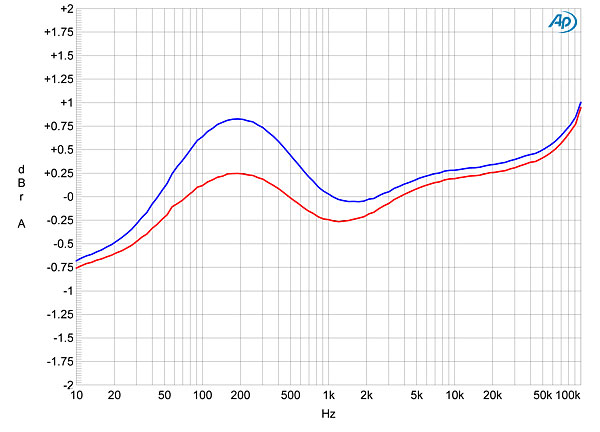
The phono-stage overload margins were simply superb at low and middle frequencies, at 30–37dB, depending on setting, and were still 20–23dB at 20kHz. Set to MM, the phono stage clipped with a 1kHz signal at 223mV, which is 33dB higher than the standard MM level of 5mV and equivalent to an output voltage of 24.75V! This is a high-dynamic-range circuit that also offered low levels of harmonic distortion. Fed 1kHz at 1mV, the MC High setting produced second-harmonic distortion of just –84dB (0.006%). Fed an equal mix of 19 and 20kHz tones at the same equivalent level, the 1kHz intermodulation product lay at –58dB, just above 0.1%, which is good.
Turning to the Luxman's line stage, line-level signals appeared at the Rec Out jacks with zero gain; and it appears that there is no buffer stage for these outputs. At the main outputs, the line stage offered a maximum gain of 15.6dB and was non-inverting. The input impedance was usefully high, at 43k ohms at 20Hz and 1kHz, dropping inconsequentially to 30k ohms at 20kHz. The output impedance was low, at 120 ohms at high and middle frequencies, but rose to 1500 ohms at the bottom of the audioband. As a result, the bass rolled off prematurely with the demanding 600 ohm load (fig.2, cyan and magenta traces). With the more realistic 100k ohm load (fig.1, blue, red), the response was flat to 10Hz and to 20kHz, and the two channels were superbly well matched. This graph was taken with the tone controls defeated and the volume control set to its maximum. Commendably, both the channel matching and measured response didn't change at lower volume-control settings.
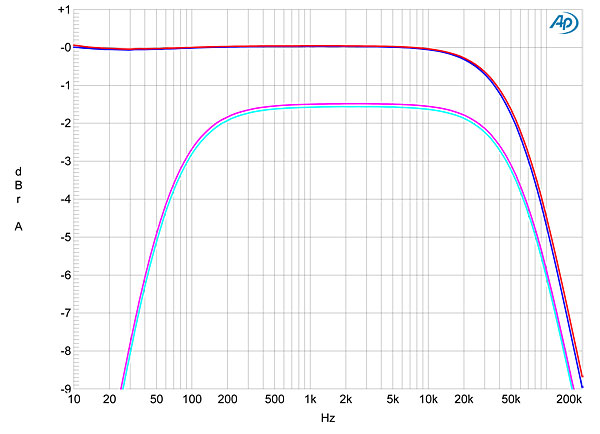
AD commented on a change in the sound when he switched from tone controls defeated to tone controls active, but with the treble and bass controls set to their central, detented positions. Not only did I measure a drop in level at 1kHz of 1.7dB with the tone controls engaged, but the treble was shelved down by –1dB at 20kHz (fig.3, middle blue and gray traces). The Lo-Cut switch rolled off the bass by 3dB at 40Hz (fig.3, middle blue trace below 200Hz), while this graph indicates that the treble and bass controls apply 10–12dB of boost or cut, which is more than generally thought necessary.
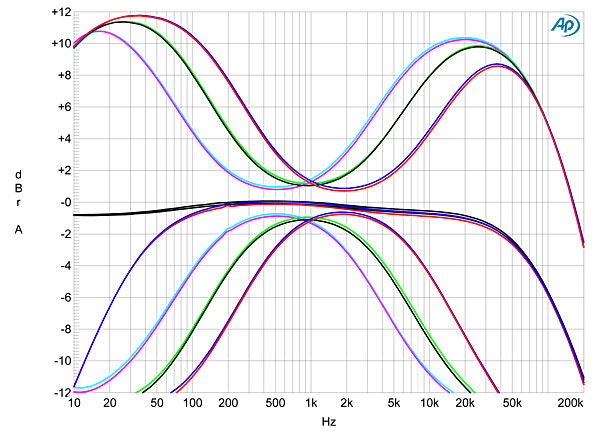
Channel separation was excellent, at >90dB in both directions in the midrange and bass, though this decreased to 60dB at the top of the audioband. The line stage's wideband, unweighted S/N ratio, ref. 1V output and taken with the inputs shorted but the volume control set to its maximum, was 78dB, this improving to 94dB when the measurement bandwidth was restricted to the audioband and to 98dB when A-weighted. Spectral analysis of the Luxman's output while it reproduced a 1kHz tone at 2V into 100k ohms (fig.4) revealed that the primary source of noise was some slight magnetic leakage from the AC transformer of 60Hz and its odd harmonics.
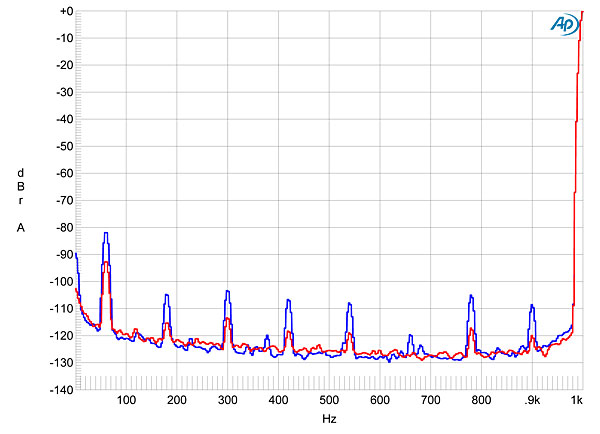
Fig.5 plots the CL-38u's percentage of THD+noise against output voltage at 1kHz into 100k ohms. The downward slope of the trace below 600mV indicates that the distortion lies below the noise up to this level, and while the THD starts to rise above 1V, it is still very low at all levels at which the Luxman preamp will be used in practice. As I said before, the CL-38u is a high-dynamic-range design—its line stage doesn't actually clip (1% THD+N) until 37V! Though the preamplifier was less happy driving low impedances (fig.6), as long as it is used to drive loads greater than 10k ohms it will offer very low distortion. The line-stage's distortion signature was primarily second harmonic (fig.7), and intermodulation distortion was also low (fig.8).
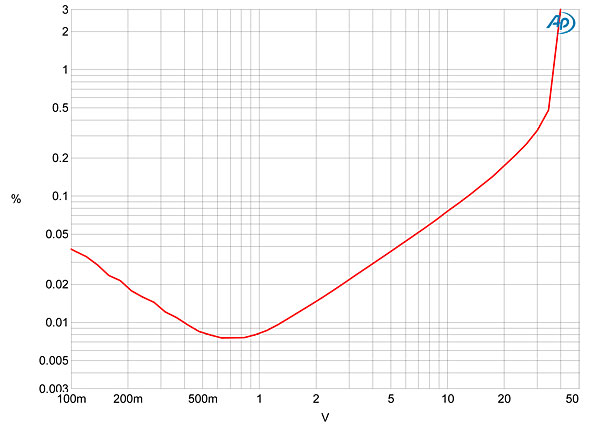
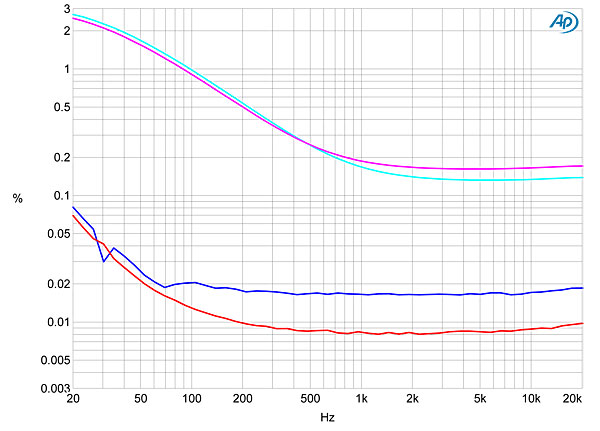
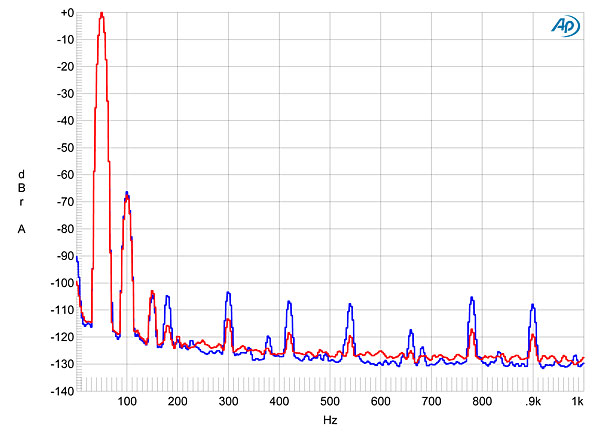
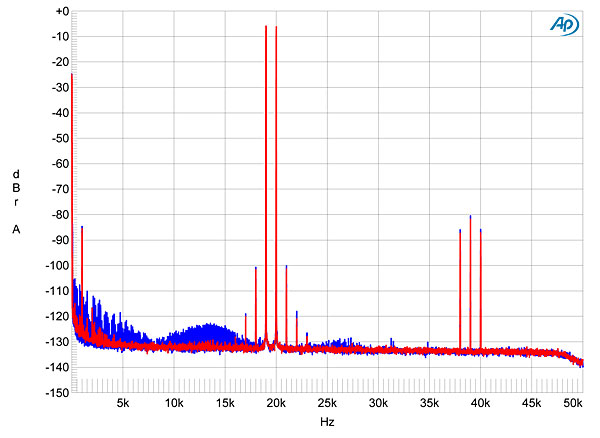
These days, full-function preamplifiers such as this one, offering MM and MC phono inputs as well as versatile tone controls, are rare—but the measured performance of Luxman's Classic CL-38u doesn't appear to be compromised in any way, either by its versatility or by its exclusive use of tubes.—John Atkinson

these reviews and content in general are hitting stereophile.com so quickly now I'm beginning to wonder whether I still need a digital subscription.

these reviews and content in general are hitting stereophile.com so quickly now I'm beginning to wonder whether I still need a digital subscription.
This is due to how the calendar crumbles each month.
John Atkinson
Editor, Stereophile

I was in retail in Canterbury in the early eighties just as Luxman stopped making rather lovely things like the L80V http://www.hifiengine.com/images/model/luxman_l-80_front_panel.jpg which were replaced with bland industrial looking gear. Good to see them back. Thanks for the heads up on the timing, frankly Art is worth the price of admission alone.

you've got going on there, Art. I think you'd have to be blind to mistake that Luxman for a Marantz 7.Other than the fact they're both tube preamps with some switches in the middle, I fail to see any cosmetic resemblance whatsoever. the panels are completely different colors, the Marantz cabinet was walnut, the Marantz switches were old fashioned toggles with bakelite knobs,the power switch was an old fashioned slide switch, etc. BTW "C" just meant it came with the cabinet. There was never a Marantz 7A or B., and officially it was always known simply as the Marantz 7.

Yeah but the digital subscription is so cheap I feel comfortable knowing that Art and others at Stereophile are being supported to continue reviewing such great products. Still have my old Luxman L-450 with digital tuner and cassette deck at my parent's place, after all these years they still run great. Love Luxman's gear and have come full circle on their turntable, once thought it ugly now think it is quite attractive.

I noticed JA mentioned in the measurement column the CL-38U's polarity is reversed on MC loads. How pervasive is this on other equipment? If it does occur, then shouldn't that information be in the review copy? It's my understanding that polarity can be corrected by reversing the sources RCA/XLR into the troubled (?) unit. Is that true? I admit to knowing very little about checking and compensating for polarity would love further explanation whether that be in the pages of Stereophile or elsewhere. Thanks!

When RELATIVE POLARITY is miswired the left and right speakers will not agree as to whether the speaker is moving IN or OUT.
One speaker will be playing INWARD notes and the other speaker will be playing OUTWARD notes.
That is because the plus and minus terminals on ONE speaker have the leads REVERSED somewhere in the chain. Unless you bought some really BAD stuff this has occurred by Operator Error and YOU wired one speaker BACKWARDS---YOUR bad.
Positive lead is wired to Minus terminal and Minus lead is wired to Positive terminal. On ONE speaker only.
What John caught is NOT this problem (which would really have messed up the sound terribly and made the bass sound weak as heck)...
John noticed ABSOLUTE POLARITY was miswired.
Which is when ALL the wires are hooked up to the WRONG terminals. On BOTH channels.
So your speakers would play together as they moved IN and OUT. BUT---they would play INTO their cabinets instead of OUT of their cabinets. The speakers would drive the sound INTO the box instead of driving the sound OUT to the air.
It all sounds a bit DEAD when you do that. Exactly as though you were making the sound play INTO the box instead of playing OUT into the room. MUFFLED. Very CLEAR. But MUFFLED.
But not terribly so. It is an effect you really have to pay attention to notice. And have really well set up gear in the first place.
And what is WORSE is that SOME recordings were accidentally encoded with everything reversed. AND BAD RECORDINGS WILL BE PLAYED CORRECTLY WHEN THE POLARITY IS ABSOLUTELY REVERSED.
Just to make all of us crazy. Haha.
But anyway---It is there. It is real.
But probably NOT the first thing you might hate about your new Stereo.
I once accused Benchmark of having their phase reversed on the DAC1. Their engineer called me back and said: "wrong." "It is NOT wired wrong."
Then I triple checked my setup and damn it---MINE was wired backwards.
Oh well. I will never live down the shame...
And life goes on.

Great article, great enough to make me want to buy one. However, the Luxman agent in Australia is not going to stock them, the Luxman agent in the UK is not going to stock them and "On a higher note" won't reply to my webform sales query. It is very annoying.